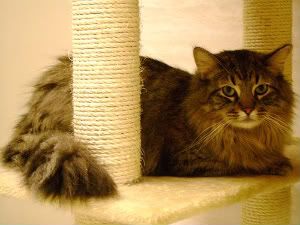
Scratching is a natural, healthy part of cat behavior, but it can be a major concern for many families with cats or who are considering adopting a cat. It’s not hard to understand why. No one likes having their furniture scratched and for people on certain medications cat scratches can be very serious, but you don’t have to make a decision between your sofa and health or having a happy feline companion.
In the United States declawing is one of the most popular solutions to scratching. Many people are surprised to find that this is a procedure unique to the United States. In many European countries (see a full list here) declawing is illegal. It is recognized as an inhumane procedure that harms the cat without providing any benefits.
(View a diagram of the bones of a cat's foot before and after declawing.)
Declawing is not the simple surgery that many believe it is. A cat’s claw is connected to a bone called the distal phalanx, which is amputated along with the deep digital flexor tendon. The closest comparison is having the tip of your fingers cut off at the first knuckle. This leaves the cat with a painful recovery, as cats do not have the option to lay in bed while their mutilated paws heal.
The psychological side effects of declawing are troubling and unacceptable. Claws are a cat’s main defense mechanism and removing it can drastically alter their personality. Some declawed cats become frightened and withdrawn while others become aggressive. Since they no longer have their claws to defend themselves, many turn to the only other means of defense they have: teeth. Declawing can also lead to a problem behavior most owners find more difficult to live with than scratching. After the surgery cats still must scratch in their litterbox and many learn to associate the pain of their damaged paws with the box itself. This can lead them to avoid the box and seek out softer surfaces to relieve themselves on. Scratching is also a means of marking territory and, deprived of this method, some cats will turn to urinating outside of the box in order to scent mark their home.
There are also physical side effects to such a serious surgery. Complications following surgery are extremely common and include hemorrhage, infection, and regrowth of nails. Scratching also allows cats to stretch their back muscles and removing this ability can cause painful seizing of the muscles.
So what are you supposed to do about scratching? Thankfully, there are many effective and, most importantly, humane methods for discouraging your cat from scratching on your furniture.
The easiest thing you can do is provide appropriate scratching surfaces for your cat. Scratching posts can be purchased at any pet store or made yourself. They come in a variety of sizes, styles, and colors. Some cats prefer upright scratching posts and some prefer horizontal surfaces. Traditional scratching posts such as these are great for cats that like, for instance, the corner of your sofa, and cardboard scratchers like these are best for cats who like to scratch on the carpet. Any scratching post can be sprayed with cat nip spray to attract the cat to it and some already come treated with cat nip.
A relatively new solution to scratching is a product called Soft Paws. These are small plastic caps that you apply to each of your cat’s claws, almost like putting on fake fingernails. They are blunt on the end so your cat can’t scratch anything, but they don’t interfere with the cat’s natural movement and don’t cause any discomfort. They are simple to apply on your own and come in many fun colors.
One of the reasons cats scratch is to shed the outer layer of their claws. If you keep their nails trimmed you can help eliminate this need. Trimming nails is a simple procedure you can do yourself with pet nail trimmers purchased from any pet store. Simply extend the cat’s nail by pressing at the base with your finger and trim off the hook of the nail. Be careful to avoid the blood line, which in most cats is easily visible. If you aren’t comfortable trimming your own cat’s nails, your veterinarian or groomer could do it for you.
Declawing is inhumane and not a reasonable reaction to scratching, but by trying some of these alternatives you can live in harmony with your feline friend without sacrificing your furniture or your cat’s wellbeing. Your cat will thank you for it.
Further reading on declawing:
www.declawing.org (Warning: this site contains graphic photos.)
HSUS’s position on declawing
Declawing in the Petfinder library
